Netgear C7100V User Manual
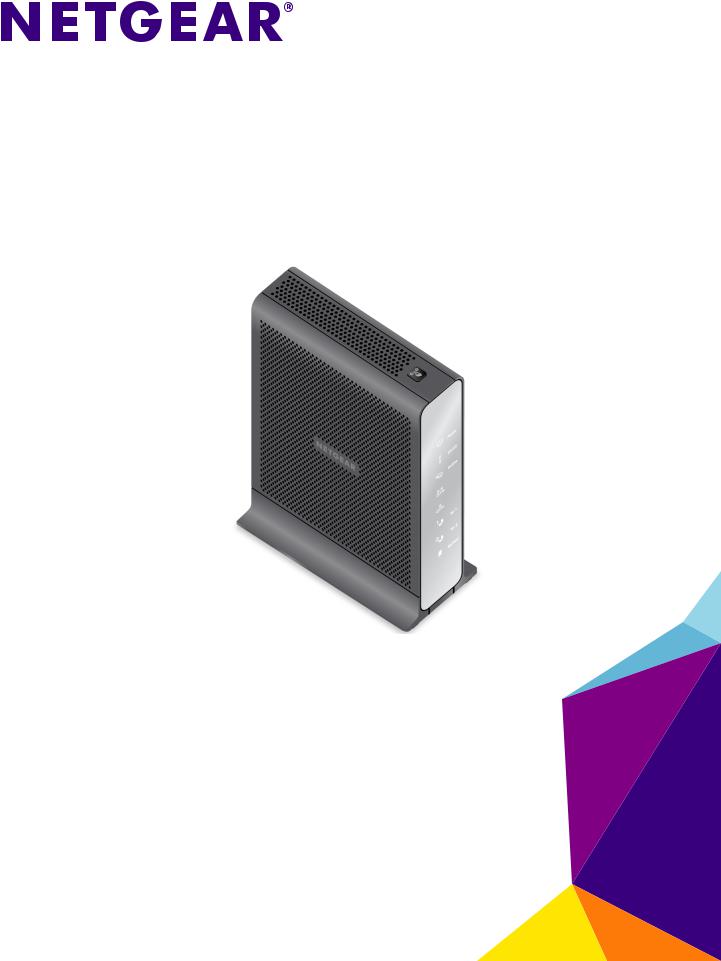
AC1900 Cable Modem Voice Router
Model C7100V
User Manual
February 2017 202-11722-01
350 East Plumeria Drive
San Jose, CA 95134
USA

AC1900 Cable Modem Voice Router
Support
Thank you for purchasing this NETGEAR product. You can visit www.netgear.com/support to register your product, get help, access the latest downloads and user manuals, and join our community. We recommend that you use only official NETGEAR support resources.
Conformity
For the current EU Declaration of Conformity, visit http://kb.netgear.com/app/answers/detail/a_id/11621.
Compliance
For regulatory compliance information, visit http://www.netgear.com/about/regulatory.
See the regulatory compliance document before connecting the power supply.
Trademarks
© NETGEAR, Inc., NETGEAR and the NETGEAR Logo are trademarks of NETGEAR, Inc. Any non-NETGEAR trademarks are used for reference purposes only.
2

AC1900 Cable Modem Voice Router
Chapter 1 Hardware Overview
Package Contents . . . . . . . . . . . . . . . . . . . . . . . . . . . . . . . . . . . . . . . . . . . . . . . . . . . . 8
Front Panel . . . . . . . . . . . . . . . . . . . . . . . . . . . . . . . . . . . . . . . . . . . . . . . . . . . . . . . . . . 8
Top Panel WPS Button . . . . . . . . . . . . . . . . . . . . . . . . . . . . . . . . . . . . . . . . . . . . . . . 10
Rear Panel . . . . . . . . . . . . . . . . . . . . . . . . . . . . . . . . . . . . . . . . . . . . . . . . . . . . . . . . . . 10
Product Label . . . . . . . . . . . . . . . . . . . . . . . . . . . . . . . . . . . . . . . . . . . . . . . . . . . . . . . 11
Install an Optional Battery . . . . . . . . . . . . . . . . . . . . . . . . . . . . . . . . . . . . . . . . . . . . 12
Replace the Battery. . . . . . . . . . . . . . . . . . . . . . . . . . . . . . . . . . . . . . . . . . . . . . . . . . 12
Position Your Modem Router. . . . . . . . . . . . . . . . . . . . . . . . . . . . . . . . . . . . . . . . . . 13
Install and Activate Your Modem Router . . . . . . . . . . . . . . . . . . . . . . . . . . . . . . . . 14
Connect Your Modem Router to a Computer. . . . . . . . . . . . . . . . . . . . . . . . . . 14
Call Comcast XFINITY to Activate Internet Service and
Register the Voice Telephone Lines . . . . . . . . . . . . . . . . . . . . . . . . . . . . . . . . . . 15
Perform a Speed Test . . . . . . . . . . . . . . . . . . . . . . . . . . . . . . . . . . . . . . . . . . . . . . 16
Chapter 2 Connect to the Network and Access the Modem Router
Connect to the Network. . . . . . . . . . . . . . . . . . . . . . . . . . . . . . . . . . . . . . . . . . . . . . 18 Wired Connection . . . . . . . . . . . . . . . . . . . . . . . . . . . . . . . . . . . . . . . . . . . . . . . . . 18 WiFi Connection . . . . . . . . . . . . . . . . . . . . . . . . . . . . . . . . . . . . . . . . . . . . . . . . . . 18 Types of Logins . . . . . . . . . . . . . . . . . . . . . . . . . . . . . . . . . . . . . . . . . . . . . . . . . . . . . 19 Log In to the Modem Router . . . . . . . . . . . . . . . . . . . . . . . . . . . . . . . . . . . . . . . . . . 20 Access the Modem Router With the NETGEAR genie App . . . . . . . . . . . . . . . . . 21
Chapter 3 Specify Your Internet Settings
Specify the Cable Connection Starting Frequency . . . . . . . . . . . . . . . . . . . . . . . 23
View Modem Router Initialization. . . . . . . . . . . . . . . . . . . . . . . . . . . . . . . . . . . . . . 24
Manually Set Up the Internet Connection . . . . . . . . . . . . . . . . . . . . . . . . . . . . . . . 25
Specify an IPv6 Internet Connection . . . . . . . . . . . . . . . . . . . . . . . . . . . . . . . . . . . 26
Change the MTU Size . . . . . . . . . . . . . . . . . . . . . . . . . . . . . . . . . . . . . . . . . . . . . . . . 27
Chapter 4 Control Access to the Internet
Set Up Parental Controls. . . . . . . . . . . . . . . . . . . . . . . . . . . . . . . . . . . . . . . . . . . . . . 31 Block Access to Your Network. . . . . . . . . . . . . . . . . . . . . . . . . . . . . . . . . . . . . . . . . 32 Use Keywords to Block Internet Sites. . . . . . . . . . . . . . . . . . . . . . . . . . . . . . . . . . . 33 Delete a Keyword . . . . . . . . . . . . . . . . . . . . . . . . . . . . . . . . . . . . . . . . . . . . . . . . . 34 Block Services From the Internet . . . . . . . . . . . . . . . . . . . . . . . . . . . . . . . . . . . . . . 35 Schedule When to Block Internet Sites and Services . . . . . . . . . . . . . . . . . . . . . . 36 Avoid Blocking on a Trusted Computer . . . . . . . . . . . . . . . . . . . . . . . . . . . . . . . . . 37 Set Up Security Event Email Notifications . . . . . . . . . . . . . . . . . . . . . . . . . . . . . . . 38 Manage Services . . . . . . . . . . . . . . . . . . . . . . . . . . . . . . . . . . . . . . . . . . . . . . . . . . . . 39 Enable or Disable NAT . . . . . . . . . . . . . . . . . . . . . . . . . . . . . . . . . . . . . . . . . . . . . . . . 41
Chapter 5 Share USB Devices Attached to the Modem Router
USB Storage Device Requirements . . . . . . . . . . . . . . . . . . . . . . . . . . . . . . . . . . . . . 43 Connect a USB Storage Device to the Modem Router . . . . . . . . . . . . . . . . . . . . 43
3

AC1900 Cable Modem Voice Router
Access a USB Drive Connected to the Modem Router From
a Windows Computer . . . . . . . . . . . . . . . . . . . . . . . . . . . . . . . . . . . . . . . . . . . . . . . . 44 Map a USB Device to a Windows Network Drive . . . . . . . . . . . . . . . . . . . . . . . . . 44 Access a USB Storage Device That Is Connected to
the Modem Router From a Mac . . . . . . . . . . . . . . . . . . . . . . . . . . . . . . . . . . . . . . . 45 Control Access to the USB Storage Device . . . . . . . . . . . . . . . . . . . . . . . . . . . . . . 45 Use FTP Within the Network . . . . . . . . . . . . . . . . . . . . . . . . . . . . . . . . . . . . . . . . . . 47 View Network Folders on a USB Storage Device . . . . . . . . . . . . . . . . . . . . . . . . . 48 Add a Network Folder on a USB Storage Device . . . . . . . . . . . . . . . . . . . . . . . . . 49 Edit a Network Folder on a USB Storage Device. . . . . . . . . . . . . . . . . . . . . . . . . . 50 Approve USB Devices . . . . . . . . . . . . . . . . . . . . . . . . . . . . . . . . . . . . . . . . . . . . . . . . 50 Access the USB Storage Device Through the Internet. . . . . . . . . . . . . . . . . . . . . 52
Set Up FTP Access Through the Internet. . . . . . . . . . . . . . . . . . . . . . . . . . . . . . 52 Access the USB Storage Device Through the Internet With FTP . . . . . . . . . . 54 Safely Remove a USB Storage Device . . . . . . . . . . . . . . . . . . . . . . . . . . . . . . . . . . 54
Chapter 6 Share a USB Printer
Install the Printer Driver and Cable the Printer. . . . . . . . . . . . . . . . . . . . . . . . . . . 57 Download the ReadySHARE Printer Utility . . . . . . . . . . . . . . . . . . . . . . . . . . . . . . 57 Install the ReadySHARE Printer Utility . . . . . . . . . . . . . . . . . . . . . . . . . . . . . . . . . . 58 Use the Shared Printer . . . . . . . . . . . . . . . . . . . . . . . . . . . . . . . . . . . . . . . . . . . . . . . 59 View or Change the Status of a Printer . . . . . . . . . . . . . . . . . . . . . . . . . . . . . . . . . 60 Use the Scan Feature of a Multifunction USB Printer . . . . . . . . . . . . . . . . . . . . . 61 Change NETGEAR USB Control Center Settings . . . . . . . . . . . . . . . . . . . . . . . . . . 62
Chapter 7 Voice Telephone Lines
Connect a Telephone Line . . . . . . . . . . . . . . . . . . . . . . . . . . . . . . . . . . . . . . . . . . . . 65
View the Voice Status . . . . . . . . . . . . . . . . . . . . . . . . . . . . . . . . . . . . . . . . . . . . . . . . 65
View the MTA Call List . . . . . . . . . . . . . . . . . . . . . . . . . . . . . . . . . . . . . . . . . . . . . . . 66
View the EMTA Event Log . . . . . . . . . . . . . . . . . . . . . . . . . . . . . . . . . . . . . . . . . . . . 67
Chapter 8 Specify Network Settings
View or Change WAN Settings . . . . . . . . . . . . . . . . . . . . . . . . . . . . . . . . . . . . . . . . 69 Set Up a Default DMZ Server . . . . . . . . . . . . . . . . . . . . . . . . . . . . . . . . . . . . . . . . . 70 Manually Configure LAN Switch Ports . . . . . . . . . . . . . . . . . . . . . . . . . . . . . . . . . . 71 Change the Modem Router’s Device Name. . . . . . . . . . . . . . . . . . . . . . . . . . . . . . 72 Change the LAN TCP/IP Settings . . . . . . . . . . . . . . . . . . . . . . . . . . . . . . . . . . . . . . 72 Specify the IP Addresses That the Modem Router Assigns . . . . . . . . . . . . . . . . 73 Disable the DHCP Server Feature in the Modem Router. . . . . . . . . . . . . . . . . . . 75 Manage LAN IP Addresses . . . . . . . . . . . . . . . . . . . . . . . . . . . . . . . . . . . . . . . . . . . . 75
Reserve an IP Address . . . . . . . . . . . . . . . . . . . . . . . . . . . . . . . . . . . . . . . . . . . . . 75 Edit a Reserved IP Address Entry . . . . . . . . . . . . . . . . . . . . . . . . . . . . . . . . . . . . 76 Delete a Reserved IP Address Entry. . . . . . . . . . . . . . . . . . . . . . . . . . . . . . . . . . 77 Improve Network Connections With Universal Plug-N-Play . . . . . . . . . . . . . . . 77 Use the WPS Wizard for WiFi Connections . . . . . . . . . . . . . . . . . . . . . . . . . . . . . . 78 Specify Basic WiFi Settings . . . . . . . . . . . . . . . . . . . . . . . . . . . . . . . . . . . . . . . . . . . 79
4

AC1900 Cable Modem Voice Router
Change the WiFi Security Option . . . . . . . . . . . . . . . . . . . . . . . . . . . . . . . . . . . . . . 81 Set Up a Guest Network . . . . . . . . . . . . . . . . . . . . . . . . . . . . . . . . . . . . . . . . . . . . . . 82 Control the WiFi Radios . . . . . . . . . . . . . . . . . . . . . . . . . . . . . . . . . . . . . . . . . . . . . . 83 Use the WiFi On/Off Button . . . . . . . . . . . . . . . . . . . . . . . . . . . . . . . . . . . . . . . . 83 Enable or Disable the WiFi Radios. . . . . . . . . . . . . . . . . . . . . . . . . . . . . . . . . . . . 84 Set Up a WiFi Schedule . . . . . . . . . . . . . . . . . . . . . . . . . . . . . . . . . . . . . . . . . . . . . . . 85 Specify WPS Settings . . . . . . . . . . . . . . . . . . . . . . . . . . . . . . . . . . . . . . . . . . . . . . . . 86
Chapter 9 Manage Your Network
Change the admin Password . . . . . . . . . . . . . . . . . . . . . . . . . . . . . . . . . . . . . . . . . . 88 View Modem Router Status . . . . . . . . . . . . . . . . . . . . . . . . . . . . . . . . . . . . . . . . . . . 89 Display Internet Port Statistics . . . . . . . . . . . . . . . . . . . . . . . . . . . . . . . . . . . . . . 89 Check the Internet Connection Status. . . . . . . . . . . . . . . . . . . . . . . . . . . . . . . . 91 View the Battery Status . . . . . . . . . . . . . . . . . . . . . . . . . . . . . . . . . . . . . . . . . . . . . . 92 View and Manage Logs of Modem Router Activity . . . . . . . . . . . . . . . . . . . . . . . 92 View Event Logs . . . . . . . . . . . . . . . . . . . . . . . . . . . . . . . . . . . . . . . . . . . . . . . . . . . . 94 Run the Ping Utility . . . . . . . . . . . . . . . . . . . . . . . . . . . . . . . . . . . . . . . . . . . . . . . . . . 95 Run the Traceroute Utility . . . . . . . . . . . . . . . . . . . . . . . . . . . . . . . . . . . . . . . . . . . . 96 Monitor Internet Traffic . . . . . . . . . . . . . . . . . . . . . . . . . . . . . . . . . . . . . . . . . . . . . . 97 View Devices Currently on the Network . . . . . . . . . . . . . . . . . . . . . . . . . . . . . . . . 98 Manage the Modem Router Configuration File. . . . . . . . . . . . . . . . . . . . . . . . . . . 99 Back Up Settings . . . . . . . . . . . . . . . . . . . . . . . . . . . . . . . . . . . . . . . . . . . . . . . . . . 99 Restore Configuration Settings. . . . . . . . . . . . . . . . . . . . . . . . . . . . . . . . . . . . . 100 Erase the Current Configuration Settings . . . . . . . . . . . . . . . . . . . . . . . . . . . . 101 View Wireless Access Points in Your Area . . . . . . . . . . . . . . . . . . . . . . . . . . . . . . 101 View or Change the Modem Router Wireless Channel . . . . . . . . . . . . . . . . . . . 102 Dynamic DNS . . . . . . . . . . . . . . . . . . . . . . . . . . . . . . . . . . . . . . . . . . . . . . . . . . . . . . 103 Specify a DNS Account . . . . . . . . . . . . . . . . . . . . . . . . . . . . . . . . . . . . . . . . . . . 104 Change the Dynamic DNS Settings . . . . . . . . . . . . . . . . . . . . . . . . . . . . . . . . . 104 Remote Management . . . . . . . . . . . . . . . . . . . . . . . . . . . . . . . . . . . . . . . . . . . . . . . 105
Chapter 10 Specify Internet Port Settings
Set Up Port Forwarding to a Local Server . . . . . . . . . . . . . . . . . . . . . . . . . . . . . . 108 Add a Custom Port Forwarding Service. . . . . . . . . . . . . . . . . . . . . . . . . . . . . . 109 Edit a Port Forwarding Service . . . . . . . . . . . . . . . . . . . . . . . . . . . . . . . . . . . . . 110 Delete a Port Forwarding Entry . . . . . . . . . . . . . . . . . . . . . . . . . . . . . . . . . . . . 111 Application Example: Make a Local Web Server Public . . . . . . . . . . . . . . . . . 111 How the Modem Router Implements the Port Forwarding Rule . . . . . . . . . 112
Set Up Port Triggering . . . . . . . . . . . . . . . . . . . . . . . . . . . . . . . . . . . . . . . . . . . . . . 112 Add a Port Triggering Service . . . . . . . . . . . . . . . . . . . . . . . . . . . . . . . . . . . . . . 113 Application Example: Port Triggering for Internet Relay Chat . . . . . . . . . . . 114
Chapter 11 Troubleshooting
Troubleshoot with the LEDs . . . . . . . . . . . . . . . . . . . . . . . . . . . . . . . . . . . . . . . . . . 116 Power LED Is Off. . . . . . . . . . . . . . . . . . . . . . . . . . . . . . . . . . . . . . . . . . . . . . . . . 116 LEDs Never Turn Off. . . . . . . . . . . . . . . . . . . . . . . . . . . . . . . . . . . . . . . . . . . . . . 116
5

AC1900 Cable Modem Voice Router
Internet LED Is Off . . . . . . . . . . . . . . . . . . . . . . . . . . . . . . . . . . . . . . . . . . . . . . . 116 Troubleshoot the Cable Internet Connection . . . . . . . . . . . . . . . . . . . . . . . . . . . 116 Cannot Log In to the Modem Router . . . . . . . . . . . . . . . . . . . . . . . . . . . . . . . . . . 117 Changes Not Saved . . . . . . . . . . . . . . . . . . . . . . . . . . . . . . . . . . . . . . . . . . . . . . . . . 118 WiFi Connectivity . . . . . . . . . . . . . . . . . . . . . . . . . . . . . . . . . . . . . . . . . . . . . . . . . . 118 Phone Does Not Get a Dial Tone . . . . . . . . . . . . . . . . . . . . . . . . . . . . . . . . . . . . . . 119 Troubleshoot Your Network Using the Ping Utility . . . . . . . . . . . . . . . . . . . . . . . 119
Test the LAN Path to Your Modem Router . . . . . . . . . . . . . . . . . . . . . . . . . . . 119 Test the Path From Your Computer to a Remote Device. . . . . . . . . . . . . . . . 120
Appendix A Supplemental Information
Factory Settings . . . . . . . . . . . . . . . . . . . . . . . . . . . . . . . . . . . . . . . . . . . . . . . . . . . 123
Technical Specifications . . . . . . . . . . . . . . . . . . . . . . . . . . . . . . . . . . . . . . . . . . . . . 124
6

1. Hardware Overview |
1 |
|
|
||
|
|
|
The modem router provides you with an easy and secure way to set up a WiFi home network with fast Internet access through a coaxial cable and two VoIP telephone lines. The modem router battery (sold separately) provides up to five hours of talk time and eight hours or idle time for voice service during a power outage.
The modem router delivers combined WiFi connection speeds. High-powered amplifiers with antennas provide WiFi coverage anywhere around your home, inside or out.
To set up your new modem router, use the installation guide. This chapter provides supplemental information that can help you with the setup.
This chapter contains the following sections:
•Package Contents
•Front Panel
•Top Panel WPS Button
•Rear Panel
•Product Label
•Install an Optional Battery
•Replace the Battery
•Position Your Modem Router
•Install and Activate Your Modem Router
7
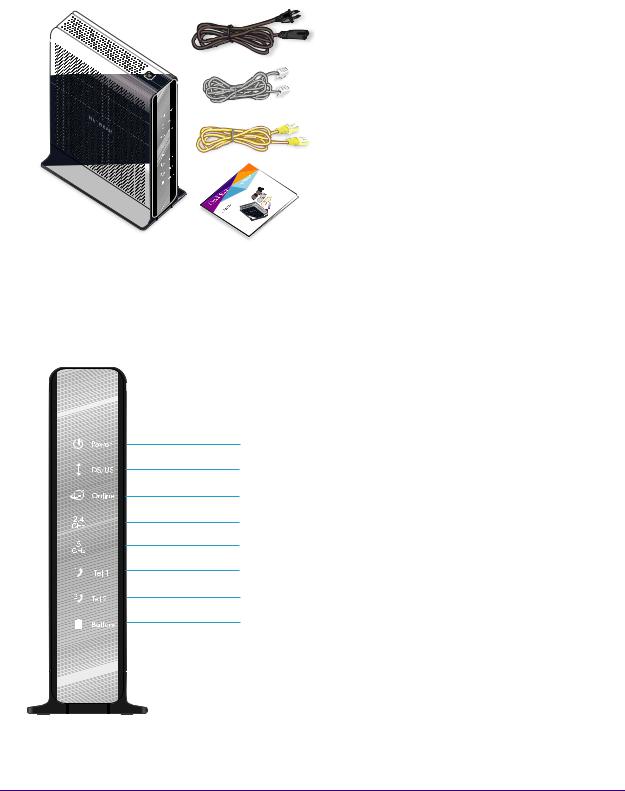
AC1900 Cable Modem Voice Router
Package Contents
Your package includes the following items.
Power cord |
Phone cable |
Ethernet cable
Quick start gude
Modem router
Figure 1. Package contents
Front Panel
The front panel contains status LEDs. Use the LEDs to verify status and connections.
Power LED
DS/US LED (downstream and upstream)
Online LED
2.4 GHz WiFi LED
5 GHz WiFi LED
Tel (voice) port 1 LED
Tel (voice) port 2 LED
Battery LED
Figure 2. Front panel LEDs
Hardware Overview
8

AC1900 Cable Modem Voice Router
You can use the LEDs to verify status and connections. The following table lists and describes each LED and the WPS button on the front panel.
Table 1. Front panel LEDs and button of the modem router
LED |
Icon |
Description |
|
|
|
Power |
|
• Solid white. The modem router is receiving power and is functioning normally. |
|
|
|
|
|
• Off. The modem router is not receiving power. |
|
|
|
|
|
|
DS/US |
|
• Solid white. One or more downstream channels are locked. |
|
|
• Slow blinking. Downstream locking is in progress. |
|
|
• Fast blinking. Upstream locking is in progress. |
|
|
• Off. No downstream channel is locked. |
Online |
• |
Solid white. The modem router is connected to the Internet. |
|
• |
Blinking. The modem router is downloading a configuration file from the cable |
|
|
provider’s CMTS. |
•Off. The modem router is not connected to the Internet.
2.4 GHz WiFi |
• |
Solid white. The 2.4 GHz WiFi radio is functioning and available for use. |
|
• |
Slow blinking. At least one computer or WiFi device is connected to the 2.4 |
|
|
GHz network or someone pressed the WPS button. |
•Fast blinking. At least one computer or WiFi device is sending or receiving data on the 2.4 GHz network.
•Off. The 2.4 GHz WiFi radio is disabled. (If the radio is disabled, see Control the WiFi Radios on page 83.)
5 GHz WiFi |
• Solid white. The 5 GHz WiFi radio is functioning and available for use. |
|
|
• Slow blinking. At least one computer or WiFi device is connected to the 5 GHz |
|
|
network or someone pressed the WPS button. |
|
|
• Fast blinking. At least one computer or WiFi device is sending or receiving |
|
|
data on the 5 GHz network. |
|
|
• Off. The 5 GHz WiFi radio is disabled. (If the radio is disabled, see Control the |
|
|
WiFi Radios on page 83.) |
|
Tel (voice) |
• Solid white. The telephone line is provisioned and ready to use. |
|
port 1 and |
||
• Slow blinking. Registration is in progress for the telephone line or the phone is |
||
Tel (voice) |
||
port 2 |
off the hook. |
|
|
• Off. The telephone line is not registered or is not provisioned. |
|
|
|
|
Battery |
• Solid white. The battery is charged. |
|
|
• Fast blinking. The battery power is low, or the modem router detected a |
|
|
grounding error or a problem with the voltage. |
|
|
• Off. The battery is not working. |
Hardware Overview
9

AC1900 Cable Modem Voice Router
Top Panel WPS Button
The WPS button is on the top panel.
WPS button
Press the WPS button 

 to connect to the WiFi network without typing the WiFi password. For more information about using WPS, see WiFi Connection on page 18.
to connect to the WiFi network without typing the WiFi password. For more information about using WPS, see WiFi Connection on page 18.
Rear Panel
The rear panel contains ports, connectors, and a recessed button.
Reset button
 USB ports (2)
USB ports (2)
Voice ports (2)
 Ethernet LAN ports (4)
Ethernet LAN ports (4)
Coaxial cable connector
Power input
Figure 3. Rear panel connections and button
The rear panel contains the following components, viewed from top to bottom:
•Reset button. To set the modem router to the original factory settings, press and hold the Reset button for at least seven seconds. For more information, see Factory Settings on page 123.
Hardware Overview
10
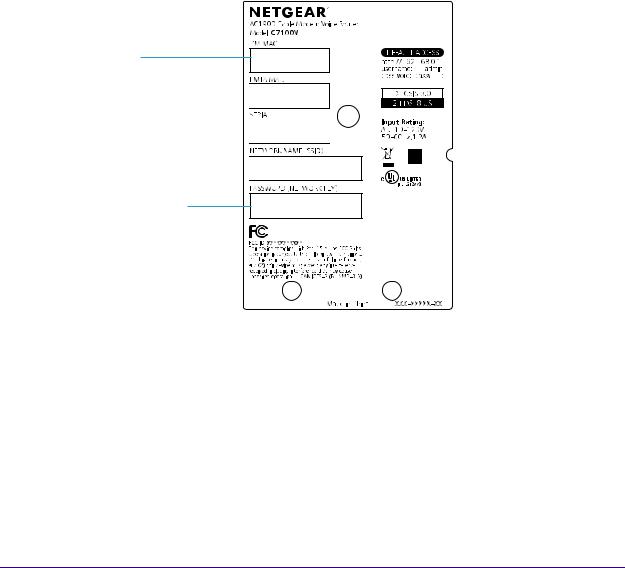
AC1900 Cable Modem Voice Router
•USB ports. The USB ports lets you connect a USB hard drive, flash drive, or printer to the modem router.
•Tel (voice) ports. Connect Voice over IP (VoIP) telephone lines.
•Four Ethernet LAN ports. These ports support 1000 Mpbs, 100 Mpbs, and 10 Mpbs connections. Use the Ethernet LAN ports to connect local computers to the modem router’s Ethernet LAN.
•Coaxial cable connector. Attach a coaxial cable to the cable service provider’s connection.
•Power input connector. Attach the power cord to this input.
Product Label
The label on the modem router shows the login information, MAC addresses, serial number, WiFi network names, and WiFi password (key).
CM MAC address
EMTA MAC address 
Serial number 

WiFi network name (SSID) 
WiFi network password
Figure 4. Modem router label
Hardware Overview
11
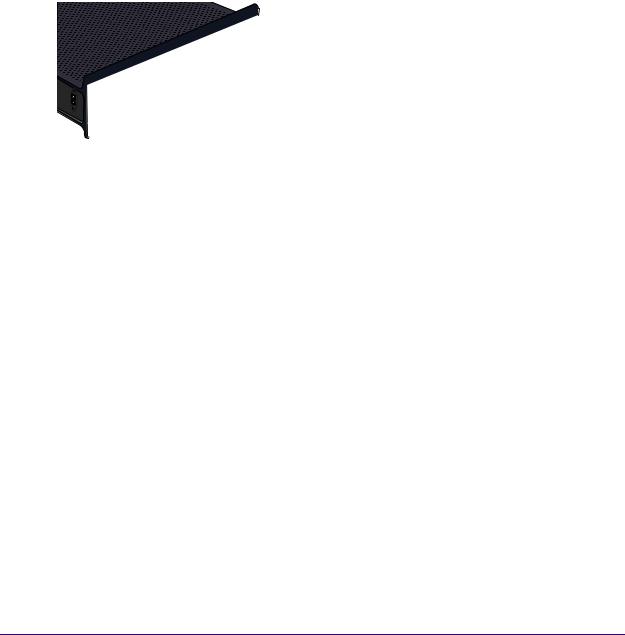
AC1900 Cable Modem Voice Router
Install an Optional Battery
A battery is not included with the modem router, but you can purchase a NETGEAR modem router battery (sold separately) and install it. The battery can give you five hours of additional talk time and eight hours of idle time for voice service during a power outage. Battery access is on the bottom of the modem router.
To install the battery:
1.Make sure that the modem router is unplugged.
2.Open the battery compartment door.
3.Insert the battery into the modem router.
Do not attempt to remove the battery’s plastic tab. The plastic tab allows you to easily remove the battery later if it must be replaced.
4. Close the battery compartment door.
Replace the Battery
Battery access is on the bottom of the modem router.
To replace the battery:
1.Unplug the modem router.
2.Open the battery compartment door.
3.Pull the plastic tab to remove the battery.
4.Insert the replacement battery and close the battery compartment door.
Hardware Overview
12

AC1900 Cable Modem Voice Router
Position Your Modem Router
The modem router lets you access your network from anywhere within the operating range of your WiFi network. However, the operating distance or range of your WiFi connection can vary significantly depending on the physical placement of your modem router. For example, the thickness and number of walls the WiFi signal passes through can limit the range.
For best results, place your modem router according to the following guidelines:
•Place your modem router on an upper floor of a multifloor home or office.
•Place your modem router near the center of the area where your computers and other devices operate, and within line of sight to your WiFi devices.
•Make sure that the modem router is within reach of an AC power outlet and near Ethernet cables for wired computers.
•Place the modem router in an elevated location, minimizing the number walls and ceilings between the modem router and your other devices.
•Place the modem router away from electrical devices such as these:
-Ceiling fans
-Home security systems
-Microwaves
-Computers
-Base of a cordless phone
-2.4 GHz cordless phone
•Place the modem router away from large metal surfaces, large glass surfaces, insulated walls, and items such as these:
-Solid metal doors
-Aluminum studs
-Fish tanks
-Mirrors
-Brick
-Concrete
When you use multiple access points, it is better if adjacent access points use different radio frequency channels to reduce interference. The recommended channel spacing between adjacent access points is five channels (for example, use Channels 1 and 6, or 6 and 11).
Hardware Overview
13

AC1900 Cable Modem Voice Router
Install and Activate Your Modem Router
The modem router provides a connection between your cable Internet provider’s network and your computer, router, or WiFi router.
Connect Your Modem Router to a Computer
During the installation and activation, you must connect the modem router directly to a computer.
|
Cable modem |
|
Cable |
|
|
wall |
Power cord |
|
outlet |
||
|
Ethernet |
cable |
Coax cable
 Phone cable
Phone cable
Figure 5. Connect the modem router directly to a computer
Note: Before you connect your modem router and contact your cable Internet provider, collect your cable account number, account phone number, and login information (your email address or user name and password).
To connect your modem router directly to a computer:
1.Connect a coaxial cable.
Use the coaxial cable that your cable company provided to connect the cable port on the modem router to a cable wall outlet. Make sure that the cable is tightly connected.
2.Turn off the computer to which you intend to connect the modem router.
3.Use the Ethernet cable provided in the package to connect the Gigabit Ethernet port on the modem router to an Ethernet port on the computer.
4.Connect one end of the phone cable to the Tel (Voice) port on the rear panel of the modem router and the other end of the phone cable to the telephone.
5.Turn on the computer.
Hardware Overview
14

AC1900 Cable Modem Voice Router
6.Connect the power cord provided in the package to the modem router and plug the power cord into an electrical outlet.
When the startup procedure is completed, the Power LED  lights white.
lights white.
7.Wait for the modem router to come online.
It takes at least 10 minutes for the modem router to come online on the network. During this time, the LED behavior is as follows:
•The Downstream/Upstream LED  blinks slowly when the modem router is locking one or more downstream channels, the LED blinks fast when the modem router is locking one or more upstream channels, and it lights solid white when one or more downstream channels are locked.
blinks slowly when the modem router is locking one or more downstream channels, the LED blinks fast when the modem router is locking one or more upstream channels, and it lights solid white when one or more downstream channels are locked.
•After the modem router registers with your cable Internet provider, the Internet LED
 lights white.
lights white.
Even though an Internet connection is established, Internet service is available only after you set it up with your cable Internet provider.
For information about how to activate your Internet service and register your telephone lines, see Call Comcast XFINITY to Activate Internet Service and Register the Voice Telephone Lines on page 15.
Call Comcast XFINITY to Activate Internet Service and Register the Voice Telephone Lines
Before you start the activation process, make sure that your account number, account phone number, and login information (your email address or user name and password) are nearby.
To activate your Internet connection with Comcast XFINITY’s self-activation process:
1.Call Comcast XFINITY customer service at 1-800-XFINITY (1-800-934-6489).
2.When asked, provide your account information and provide the modem router’s model number and MAC address, which are on the modem router label.
For more information, see Product Label on page 11.
3.Wait for Comcast XFINITY to confirm that your modem router is active.
If you do not get an Internet connection with the modem router, ask Comcast XFINITY to look for your modem router online, and do one of the following depending on what Comcast XFINITY tells you about your modem router:
•If the modem router is not visible, Comcast XFINITY can give you instructions to verify why the modem router does not connect with your high-speed Internet service.
•If the modem router is visible to Comcast XFINITY, reboot the modem router. Check your online status again.
4.If you connected telephone lines, ask Comcast XFINITY to register your voice telephone lines.
Hardware Overview
15

AC1900 Cable Modem Voice Router
The Tel (Voice) LED blinks while the phone is being registered and then lights solid white once it is registered.
After the voice line is registered, you can hear a dial tone when the phone is off-hook.
For information about voice telephone lines, see Chapter 7, Voice Telephone Lines.
Perform a Speed Test
To determine the accurate Internet speed, visit the speed test website of your cable Internet provider and perform a speed test.
If your actual speed is lower than your subscribed speed, contact your cable Internet provider.
Hardware Overview
16

2. Connect to the Network and |
2 |
|
|
||
|
Access the Modem Router |
|
|
|
|
This chapter contains the following sections:
•Connect to the Network
•Types of Logins
•Log In to the Modem Router
•Access the Modem Router With the NETGEAR genie App
17

AC1900 Cable Modem Voice Router
Connect to the Network
You can connect to the modem router’s network through a wired or WiFi connection. If you set up your computer to use a static IP address, change the settings so that it uses Dynamic Host Configuration Protocol (DHCP).
Wired Connection
You can connect your computer to the modem router using an Ethernet cable and join the modem router’s local area network (LAN).
To connect your computer to the modem router with an Ethernet cable:
1.Make sure that the modem router is receiving power (its Power LED is lit).
2.Connect an Ethernet cable to an Ethernet port on your computer.
3.Connect the other end of the Ethernet cable to one of the numbered Ethernet ports.
Your computer connects to the local area network (LAN). A message might display on your computer screen to notify you that an Ethernet cable is connected.
WiFi Connection
You can connect to the modem router’s WiFi network with Wi-Fi Protected Setup (WPS) or you can find and select the WiFi network.
To use WPS to connect to the WiFi network:
1.Make sure that the modem router is receiving power (its Power LED is lit).
2.Check the WPS instructions for your WiFi-enabled computer or mobile device.
3.Press the WPS button on the modem router.
4.Within two minutes, on your computer or mobile device, press its WPS button or follow its instructions for WPS connections.
Your computer or mobile device connects to the WiFi network.
To find and select the WiFi network:
1.Make sure that the modem router is receiving power (its Power LED is lit).
2.On your computer or mobile device, find and select the WiFi network.
Connect to the Network and Access the Modem Router
18
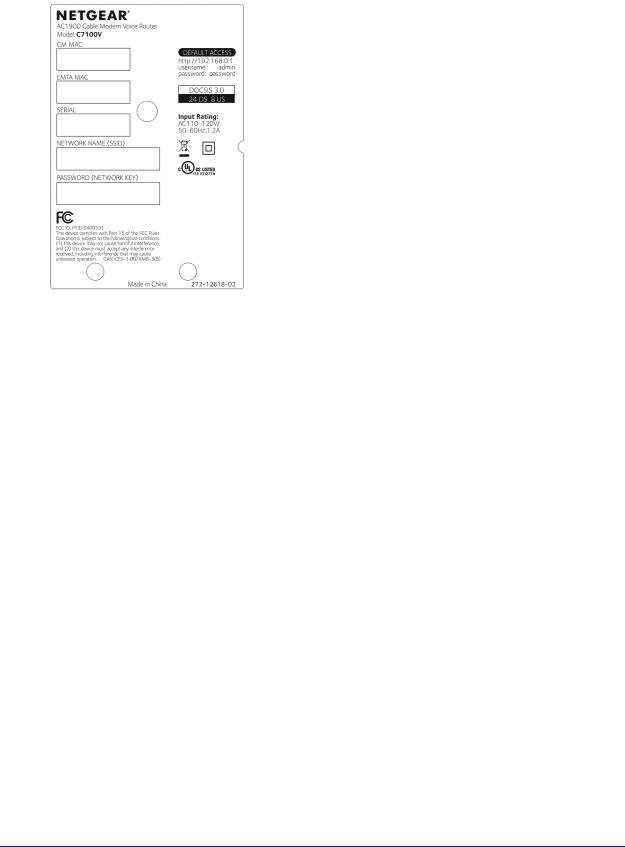
AC1900 Cable Modem Voice Router
The WiFi network name is on the modem router label.
3.Join the WiFi network and enter the WiFi password. The password is on the modem router label.
Your computer or mobile device connects to the WiFi network.
Types of Logins
Separate types of logins serve different purposes. It is important that you understand the difference so that you know which login to use when.
Types of logins:
•WiFi network key or password. Your modem router is preset with a unique WiFi network name (SSID) and password for WiFi access. This information is on the modem router label.
Note: Your modem router broadcasts dual-band 2.4 GHz and 5 GHz WiFi signals. The label shows the SSID for the 2.4 GHz signal. For information about 5 GHz WiFi settings, see Specify Basic WiFi Settings on page 79.
•Modem router login. This logs you in to the modem router interface as admin from a web browser as admin.
Connect to the Network and Access the Modem Router
19
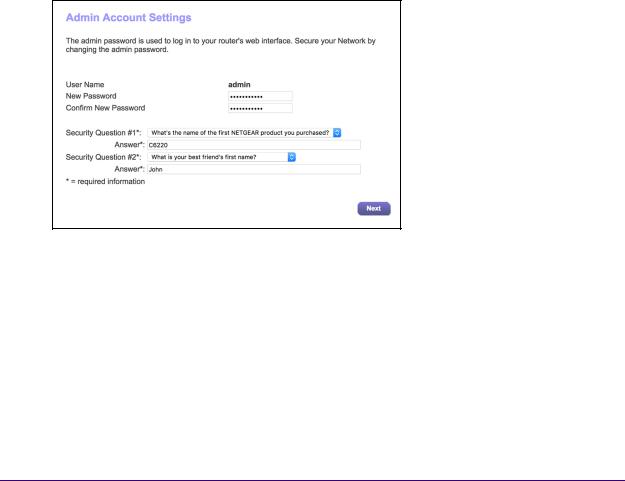
AC1900 Cable Modem Voice Router
Log In to the Modem Router
When you connect to the network (either with WiFi or with an Ethernet cable), you can use a web browser to access the modem router to view or change its settings. The first time you access the modem router, the modem router automatically checks to see if it can connect to your Internet service.
To log in to the modem router:
1.Launch an Internet browser from a computer or mobile device that is connected to the network.
2.Type http://www.routerlogin.net or http://www.routerlogin.com. A login window opens.
3.Enter the modem router user name and password.
The user name is admin. The default password is password. The user name and password are case-sensitive.
The first time you log in to the modem router, you are prompted to change the admin password and set up security questions. You must enter these settings before you can access the Internet.
4.Enter a new password.
5.Select security questions and enter the answers.
Connect to the Network and Access the Modem Router
20
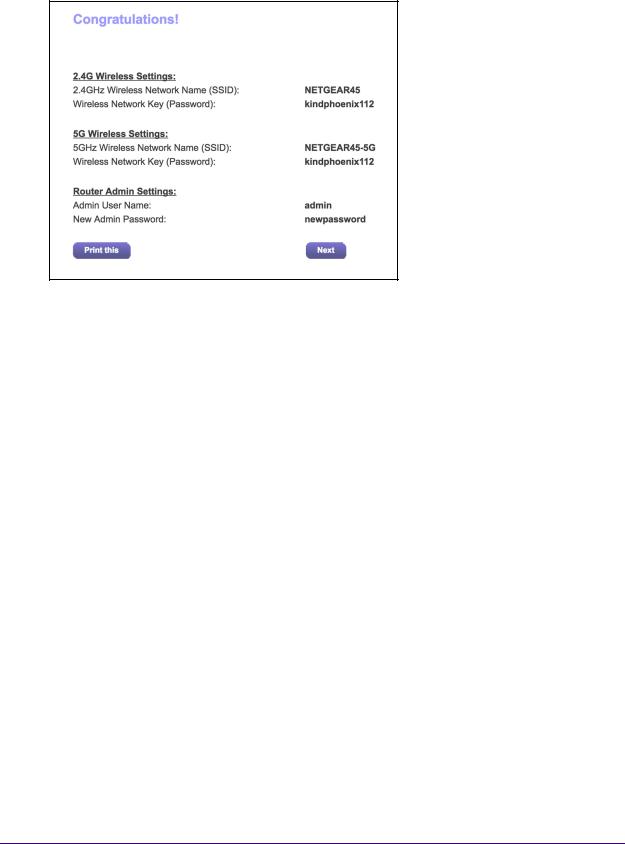
AC1900 Cable Modem Voice Router
6. Click the Next button.
7.Click the Next button.
The modem router connects to the Internet. The BASIC Home page displays the status of the Internet connection.
Access the Modem Router With the NETGEAR genie App
The genie app is the easy dashboard for managing, monitoring, and repairing your home network. The genie app can help you with the following:
•Automatically repair common WiFi network problems.
•Easily manage modem router features like Live Parental Controls, guest access, Internet traffic meter, speed test, and more.
To use the genie app to access the modem router:
1. Visit the NETGEAR genie web page at NETGEAR.com/genie.
2. Follow the onscreen instructions to install the app on your smartphone, tablet, or computer. 3. Launch the genie app.
The genie app dashboard page displays.
Connect to the Network and Access the Modem Router
21

3. Specify Your Internet Settings |
3 |
|
|
||
|
|
|
Usually, the quickest way to set up the modem router to use your Internet connection is to allow the modem router to detect the Internet connection when you first access the modem router with a web browser. You can also customize or specify your Internet settings.
This chapter contains the following sections:
•Specify the Cable Connection Starting Frequency
•View Modem Router Initialization
•Manually Set Up the Internet Connection
•Specify an IPv6 Internet Connection
•Change the MTU Size
22
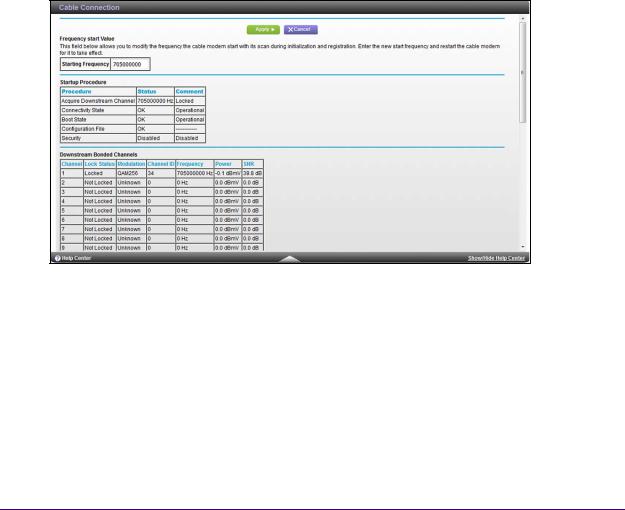
AC1900 Cable Modem Voice Router
Specify the Cable Connection Starting Frequency
The starting frequency is automatically generated. For most Internet connections, you do not need to specify this information. If you must enter a starting frequency, contact your Internet provider.
To change the starting frequency:
1.Launch a web browser from a computer or mobile device that is connected to the network.
2.Type http://routerlogin.net or http://192.168.0.1. A login window opens.
3.Enter the modem router user name and password.
The user name is admin. The default password is password. The user name and password are case-sensitive.
The BASIC Home page displays.
4.Select Cable Connection.
The page displays the status of all downstream and upstream channels.
5.In the Starting Frequency field, type a number.
6.Click the Apply button. Your settings are saved.
Specify Your Internet Settings
23
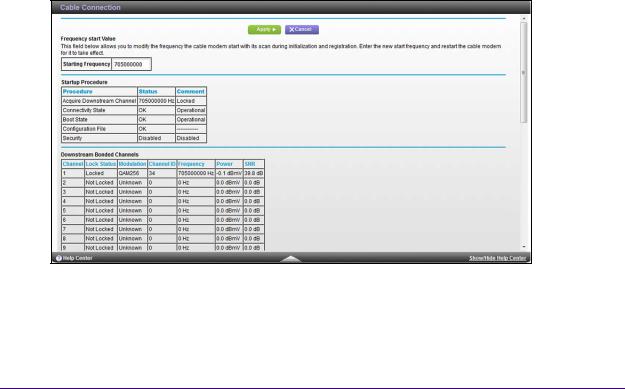
AC1900 Cable Modem Voice Router
View Modem Router Initialization
You can track the initialization procedure of the modem router and get details about the downstream and upstream cable channel. The time is displayed after the modem router is initialized.
The modem router automatically goes through the following steps in the provisioning process:
1.Scans and locks the downstream frequency and then ranges the upstream channels.
2.Obtains a WAN address for the modem router.
3.Connects to the Internet.
To view the status of the modem router initialization:
1.Launch a web browser from a computer or mobile device that is connected to the network.
2.Type http://routerlogin.net or http://192.168.0.1. A login window opens.
3.Enter the modem router user name and password.
The user name is admin. The default password is password. The user name and password are case-sensitive.
The BASIC Home page displays.
4.Select Cable Connection.
The Startup Procedure section displays the initialization progress. The page also displays the status of all downstream and upstream channels.(Scroll down to view all the channels.) The number of downstream and upstream channels that are locked depends on the number of channels that your Internet provider uses.
Specify Your Internet Settings
24
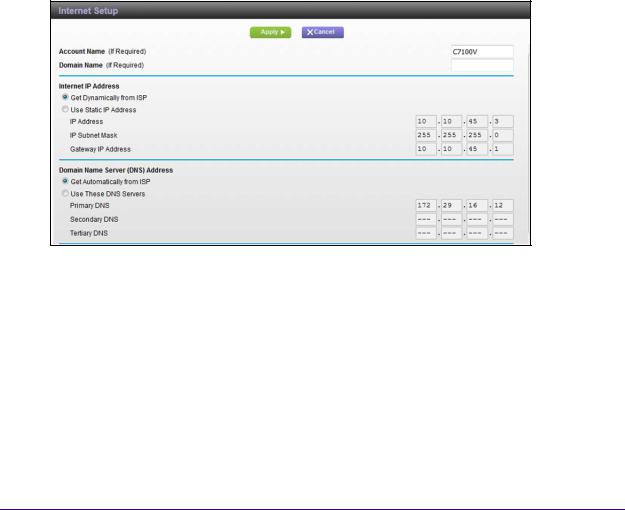
AC1900 Cable Modem Voice Router
Manually Set Up the Internet Connection
In most situations, you do not need to change these settings. We recommend that you use the default settings for DHCP because most cable Internet services provide the IP address through DHCP.
To specify the Internet connection settings:
1.Launch an Internet browser from a computer or mobile device that is connected to the network.
2.Type http://www.routerlogin.net or http://www.routerlogin.com. A login window opens.
3.Enter the modem router user name and password.
The user name is admin. The default password is password. The user name and password are case-sensitive.
The BASIC Home page displays.
4.Select ADVANCED > Setup > Internet.
5.If your Internet connection requires an account name or host name, type it in the Account Name (If Required) field.
6.If your Internet connection requires a domain name, type it in the Domain Name (If Required) field.
For the other sections in this page, the default settings usually work, but you can change them.
7.Select an Internet IP Address radio buttons:
•Get Dynamically from ISP. Your ISP uses DHCP to assign your IP address. Your ISP automatically assigns these addresses.
Specify Your Internet Settings
25

AC1900 Cable Modem Voice Router
•Use Static IP Address. Enter the IP address, IP subnet mask, and gateway IP address that your ISP assigned. The gateway is the ISP modem router to which your modem router connects.
8.Select a Domain Name Server (DNS) Address radio button:
•Get Automatically from ISP. Your ISP uses DHCP to assign your DNS servers. Your ISP automatically assigns this address.
•Use These DNS Servers. If you know that your ISP requires specific servers, select this option. Enter the IP address of your ISP’s primary DNS server. If a secondary DNS server address is available, enter it also.
9.Select a Router MAC Address radio button:
•Use Default Address. Use the default MAC address.
•Use Computer MAC Address. The modem router captures and uses the MAC address of the computer that you are now using. You must use the one computer that the ISP allows.
•Use This MAC Address. Enter the MAC address that you want to use.
10.Click the Apply button. Your settings are saved.
If the NETGEAR website does not display within one minute, see Chapter 11, Troubleshooting.
Specify an IPv6 Internet Connection
To specify an IPv6 Internet connection:
1.Launch an Internet browser from a computer or mobile device that is connected to the network.
2.Type http://www.routerlogin.net or http://www.routerlogin.com. A login window opens.
3.Enter the modem router user name and password.
The user name is admin. The default password is password. The user name and password are case-sensitive.
The BASIC Home page displays.
Specify Your Internet Settings
26
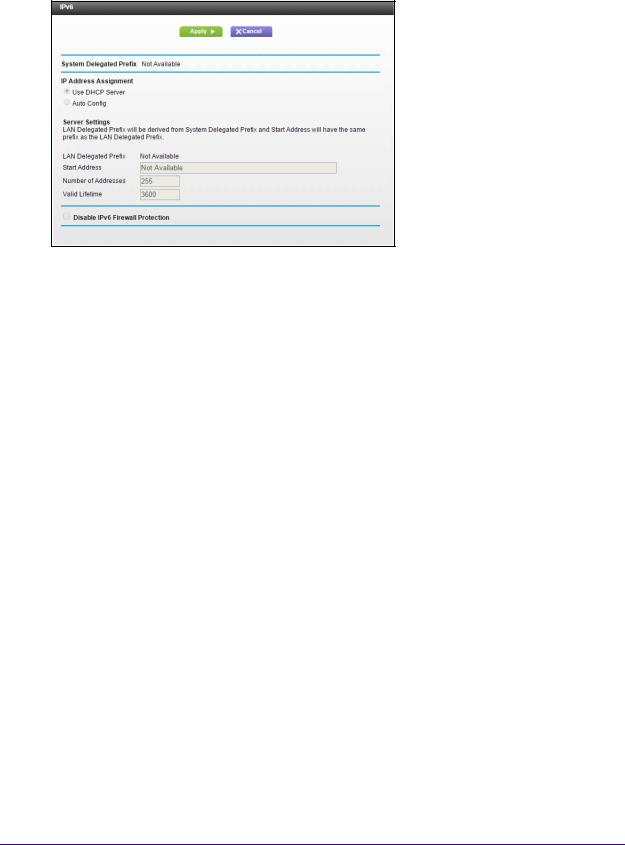
AC1900 Cable Modem Voice Router
4. Select ADVANCED > Advanced Setup > IPv6.
If your Internet provider supports IPV6, the System Delegated Prefix field displays IPv6 information.
5.Select an IP Address Assignment radio button:
•Use DHCP Server. This method passes more information to LAN devices, but some IPv6 systems might not support the DHCP client function.
•Auto Config. This is the default setting.
This setting specifies how the modem router assigns IPv6 addresses to the home network (the LAN).
6.Complete the fields in the Server Settings section.
7.Click the Apply button. Your settings are saved.
Change the MTU Size
The maximum transmission unit (MTU) is the largest data packet a network device transmits. When one network device communicates across the Internet with another, the data packets travel through many devices along the way. If a device in the data path uses a lower MTU setting than the other devices, the data packets must be split or “fragmented” to accommodate the device with the smallest MTU.
The best MTU setting for NETGEAR equipment is often the default value. In some situations, changing the value fixes one problem but causes another. Leave the MTU unchanged unless one of these situations occurs:
Specify Your Internet Settings
27
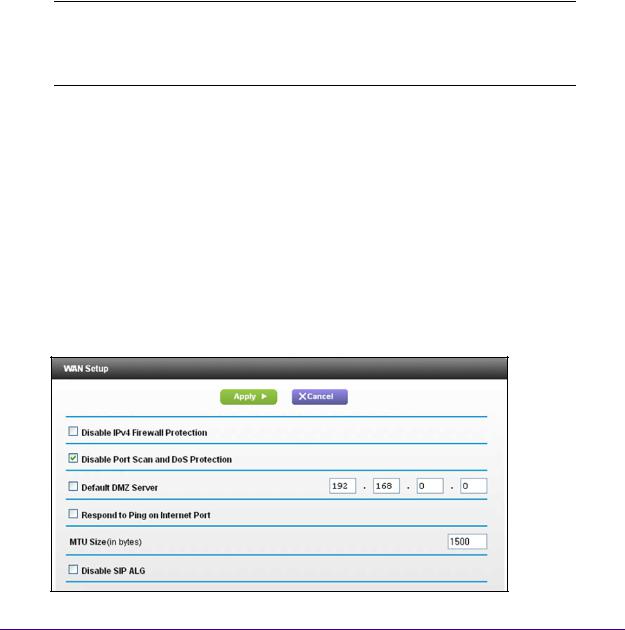
AC1900 Cable Modem Voice Router
•You experience problems connecting to your ISP or other Internet service, and the technical support of either the ISP or NETGEAR recommends changing the MTU setting. These web-based applications might require an MTU change:
-A secure website that does not open, or displays only part of a web page
-Yahoo email
-MSN portal
-America Online’s DSL service
•You use VPN and experience severe performance problems.
•You used a program to optimize MTU for performance reasons, and now you are experiencing connectivity or performance problems.
Note: An incorrect MTU setting can cause Internet communication problems. For example, you might not be able to access certain websites, frames within websites, secure login pages, or FTP or POP servers.
To change the MTU size:
1.Launch an Internet browser from a computer or mobile device that is connected to the network.
2.Type http://www.routerlogin.net or http://www.routerlogin.com. A login window opens.
3.Enter the modem router user name and password.
The user name is admin. The default password is password. The user name and password are case-sensitive.
The BASIC Home page displays.
4.Select ADVANCED > Setup > WAN Setup.
Specify Your Internet Settings
28

AC1900 Cable Modem Voice Router
5.In the MTU Size field, enter a value from 64 to 1500.
6.Click the Apply button. Your settings are saved.
If you suspect an MTU problem, a common solution is to change the MTU to 1400. If you are willing to experiment, you can gradually reduce the MTU from the maximum value of 1500 until the problem goes away. The following table describes common MTU sizes and applications.
Table 2. Common MTU sizes
MTU |
Application |
|
|
1500 |
The largest Ethernet packet size. This setting is typical for connections that do not use |
|
PPPoE or VPN, and is the default value for NETGEAR routers, adapters, and switches. |
|
|
1492 |
Used in PPPoE environments. |
|
|
1472 |
Maximum size to use for pinging. (Larger packets are fragmented.) |
|
|
1468 |
Used in some DHCP environments. |
|
|
1460 |
Usable by AOL if you do not use large email attachments, for example. |
|
|
Specify Your Internet Settings
29

4. Control Access to the Internet |
4 |
|
|
||
|
|
|
The modem router comes with a built-in firewall that helps protect your home network from unwanted intrusions from the Internet.
This chapter includes the following sections:
•Set Up Parental Controls
•Block Access to Your Network
•Use Keywords to Block Internet Sites
•Block Services From the Internet
•Schedule When to Block Internet Sites and Services
•Avoid Blocking on a Trusted Computer
•Set Up Security Event Email Notifications
•Manage Services
•Enable or Disable NAT
30
